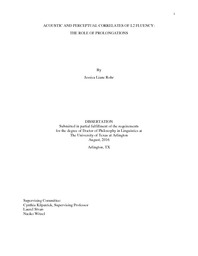
ATTENTION: The works hosted here are being migrated to a new repository that will consolidate resources, improve discoverability, and better show UTA's research impact on the global community. We will update authors as the migration progresses. Please see MavMatrix for more information.
Show simple item record
| dc.contributor.advisor | Kilpatrick, Cynthia | |
| dc.creator | Rohr, Jessica Liane | |
| dc.date.accessioned | 2016-10-25T20:50:33Z | |
| dc.date.available | 2016-10-25T20:50:33Z | |
| dc.date.created | 2016-08 | |
| dc.date.issued | 2016-09-14 | |
| dc.date.submitted | August 2016 | |
| dc.identifier.uri | http://hdl.handle.net/10106/26177 | |
| dc.description.abstract | This dissertation examines the contribution of lengthened segments/syllables or prolongations to the utterance and perceived fluency of native and non-native speech via three related studies. First, utterance fluency was measured using speech samples collected from a narrative task and along nine temporal variables of fluency (mean length of run, speech rate, mean length of syllable, mean length of silent pause, and rates of silent pause, filled pause, self-corrections, repetitions, and prolongations) (Skehan, 2007; Bosker, 2014). Results showed native speakers spoke significantly faster and with fewer disfluencies than their non-native counterparts.
Prolongations were further investigated for frequency, duration, syntactic and phonological distribution in both native and non-native speech. This study showed non-native speech contained more prolonged syllables per speech sample (calculated as a ratio to total syllables) than non-native speech. Native speakers were more likely to prolong syllable-final segments of function words at clausal boundaries. Non-native speakers, by contrast, were less likely to prolong at clausal boundaries, and were more likely to prolong content and function words equally, factors which point to the learner’s need for additional planning time and which likely contribute to impressionistic differences in native and non-native prolongation use.
Finally, a perceptual experiment utilized speech samples manipulated for clause position (initial, non-initial) and frequency (high, low) showed that naïve native raters were able to judge the relative fluency of both native and non-native speech (contra Riggenbach, 1991; Davies, 2003). Results also showed non-native speakers were rated less fluent regardless of prolongation placement or frequency, but raters were sensitive to the clause position condition in native speech. These findings suggest native-like placement is more salient than frequency in determining overall fluency. Moreover, they show raters are sensitive to the misuse of prolongations even when all other disfluencies are removed, indicating that prolongations deserve more individual attention in fluency research. | |
| dc.format.mimetype | application/pdf | |
| dc.subject | Prolongations | |
| dc.subject | Fluency | |
| dc.subject | Disfluency | |
| dc.title | Acoustic and Perceptual Correlates of L2 Fluency: The Role of Prolongations | |
| dc.type | Thesis | |
| dc.degree.department | Linguistics | |
| dc.degree.name | Doctor of Philosophy in Linguistics | |
| dc.date.updated | 2016-10-25T20:51:05Z | |
| thesis.degree.department | Linguistics | |
| thesis.degree.grantor | The University of Texas at Arlington | |
| thesis.degree.level | Doctoral | |
| thesis.degree.name | Doctor of Philosophy in Linguistics | |
| dc.type.material | text | |
Files in this item
- Name:
- ROHR-DISSERTATION-2016.pdf
- Size:
- 1.683Mb
- Format:
- PDF
This item appears in the following Collection(s)
Show simple item record


